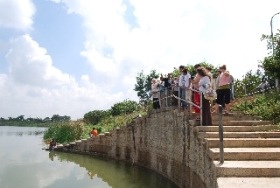Contested Urban Spaces
Report on ESG Program for University of Washington at Seattle
Download pdf version here.
In collaboration with Dr. Anu Taranath, faculty study abroad program director at the University of Washington Seattle, Environment Support Group (ESG) sponsored a one-week workshop from 11-19 August 2009 on “Contested Urban Spaces” for twenty undergraduate and graduate students. Studying themes of social justice, urbanization, and human rights in Bangalore, the students were exposed to a breadth of environmental issues through presentations, discussions, and field visits facilitated ESG.
Beginning with an overview of Bangalore’s development and environmental issues associated with such expansion, Coordinator of ESG Leo Saldanha provided historical context for the workshop during the first two days. Utilizing a multi-disciplinary approach, environmental and social justice campaigns of ESG were linked to the unhindered radial growth and insular urban planning structures of the city.

Accompanied by pictures of old Bangalore, Bhargavi Rao of ESG elaborated on the formation, or lack thereof, of infrastructure within the city, especially becoming apparent in the last few decades with the growth of the technology industry. Adding a cultural perspective to analysis of Bangalore’s urban spaces, the importance of markets, street vendors, and pedestrian walkways were introduced to students through field visits. The ESG team led students to a local tank nearby one of Kempegowda’s Towers, a temple, and even through K.R. Market, where students were asked to complete a scavenger hunt for traditional food items. From these hands-on experiences, students were able to achieve a deeper understanding of the complex networks of people and patterns of land use which complicate all aspects of public life.

The challenges confronting the city’s population were even more keenly understood as students were introduced to communities affected by the construction of the metro. Student groups led by ESG team members Nandini, Divya, Nidhi, and Samantha, visited R.V. Road, Avenue Road, and C.M.H Road, speaking with shopkeepers, restaurant owners, lawyers, activists and homeowners about their concerns with demolition of property, decreasing business, reduced tree cover, and changing traffic patterns. Students later set up appointments and met with officials associated with metro construction, town planning, and traffic safety, enabling them to examine the official approach to development which is affecting countless human livelihoods. Later discussions on their visits suggested that students appreciated the opportunity to gain a real understanding of the harsh realities of development which they had only previously encountered in textbooks.
Providing another viewpoint on urban spaces in Bangalore, Mr. Arul Selva, editor of Slum Jagathu magazine, offered a sharp critique of the circumstances which lead to such gross disparities in quality of life between groups of people living in such close physical and social proximity. Most visibly demonstrated by “slum” communities, such divisions exist in practically every public space, from planned layouts to roads improved for the sole purpose of allowing cars to move faster.

Concluding the program’s field visits, the ESG team led students to three lakes in the city, each with varying levels of human interaction and environmental integrity. The first stop at the relatively serene and clean Agara Lake, frequented by fishermen and people washing clothes, represented a victory of concerned citizens and organizations, including ESG, who fought against lake privatization. Yellamallapachetty Lake, polluted by surrounding factories and sewage, demonstrated the unfortunate transformation most lakes in Bangalore are experiencing; destroyed by the thoughtless acts of a few decision makers, the lake is still visited by fishermen who sell their (likely toxic) catch. Lastly, a stop at Vengaina Kere, now a private amusement park, challenged the students’ perception of public urban spaces, as the lake is maintained by the company, but is restricted only to ticket buyers.
With presentations, readings, and discussions encompassing interwoven themes of development, classes, wealth, environment, and human rights, field visits provided the real life, visual connections for students to engage and process. As discussed during a final discussion session between students and ESG, the stark difference in perspective between those who are stakeholders and those who are outsiders, especially demonstrated through access to public spaces, was strongly felt through this program.

